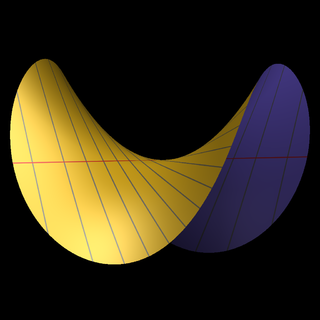In mathematics, complex geometry is the study of complex manifolds and functions of several complex variables. Application of transcendental methods to algebraic geometry falls in this category, together with more geometric aspects of complex analysis.

Algebraic varieties are the central objects of study in algebraic geometry. Classically, an algebraic variety is defined as the set of solutions of a system of polynomial equations over the real or complex numbers. Modern definitions generalize this concept in several different ways, while attempting to preserve the geometric intuition behind the original definition.

In algebraic geometry, a projective variety over an algebraically closed field k is a subset of some projective n-space over k that is the zero-locus of some finite family of homogeneous polynomials of n + 1 variables with coefficients in k, that generate a prime ideal, the defining ideal of the variety. Equivalently, an algebraic variety is projective if it can be embedded as a Zariski closed subvariety of .

In mathematics, birational geometry is a field of algebraic geometry in which the goal is to determine when two algebraic varieties are isomorphic outside lower-dimensional subsets. This amounts to studying mappings that are given by rational functions rather than polynomials; the map may fail to be defined where the rational functions have poles.
In mathematics, the canonical bundle of a non-singular algebraic variety of dimension over a field is the line bundle , which is the nth exterior power of the cotangent bundle Ω on V.

In algebraic geometry, a linear system of divisors is an algebraic generalization of the geometric notion of a family of curves; the dimension of the linear system corresponds to the number of parameters of the family.
In algebraic geometry, divisors are a generalization of codimension-1 subvarieties of algebraic varieties. Two different generalizations are in common use, Cartier divisors and Weil divisors. Both are ultimately derived from the notion of divisibility in the integers and algebraic number fields.

In mathematics, blowing up or blowup is a type of geometric transformation which replaces a subspace of a given space with all the directions pointing out of that subspace. For example, the blowup of a point in a plane replaces the point with the projectivized tangent space at that point. The metaphor is that of zooming in on a photograph to enlarge part of the picture, rather than referring to an explosion.
In algebraic geometry, an algebraic variety or scheme X is normal if it is normal at every point, meaning that the local ring at the point is an integrally closed domain. An affine variety X is normal if and only if the ring O(X) of regular functions on X is an integrally closed domain. A variety X over a field is normal if and only if every finite birational morphism from any variety Y to X is an isomorphism.
In mathematics, in particular the subfield of algebraic geometry, a rational map or rational mapping is a kind of partial function between algebraic varieties. This article uses the convention that varieties are irreducible.

In number theory and algebraic geometry, the Tate conjecture is a 1963 conjecture of John Tate that would describe the algebraic cycles on a variety in terms of a more computable invariant, the Galois representation on étale cohomology. The conjecture is a central problem in the theory of algebraic cycles. It can be considered an arithmetic analog of the Hodge conjecture.
In algebraic geometry, the Chow groups of an algebraic variety over any field are algebro-geometric analogs of the homology of a topological space. The elements of the Chow group are formed out of subvarieties in a similar way to how simplicial or cellular homology groups are formed out of subcomplexes. When the variety is smooth, the Chow groups can be interpreted as cohomology groups and have a multiplication called the intersection product. The Chow groups carry rich information about an algebraic variety, and they are correspondingly hard to compute in general.
In mathematics, an algebraic cycle on an algebraic variety V is, roughly speaking, a homology class on V that is represented by a linear combination of subvarieties of V. Therefore, the algebraic cycles on V are the part of the algebraic topology of V that is directly accessible in algebraic geometry. With the formulation of some fundamental conjectures in the 1950s and 1960s, the study of algebraic cycles became one of the main objectives of the algebraic geometry of general varieties.

In algebraic geometry, the problem of resolution of singularities asks whether every algebraic variety V has a resolution, a non-singular variety W with a proper birational map W→V. For varieties over fields of characteristic 0 this was proved in Hironaka (1964), while for varieties over fields of characteristic p it is an open problem in dimensions at least 4.
In algebraic geometry, flips and flops are codimension-2 surgery operations arising in the minimal model program, given by blowing up along a relative canonical ring. In dimension 3 flips are used to construct minimal models, and any two birationally equivalent minimal models are connected by a sequence of flops. It is conjectured that the same is true in higher dimensions.
In algebraic geometry, the Iitaka dimension of a line bundle L on an algebraic variety X is the dimension of the image of the rational map to projective space determined by L. This is 1 less than the dimension of the section ring of L
In mathematics, the theorem of Bertini is an existence and genericity theorem for smooth connected hyperplane sections for smooth projective varieties over algebraically closed fields, introduced by Eugenio Bertini. This is the simplest and broadest of the "Bertini theorems" applying to a linear system of divisors; simplest because there is no restriction on the characteristic of the underlying field, while the extensions require characteristic 0.
In algebraic geometry, a morphism between algebraic varieties is a function between the varieties that is given locally by polynomials. It is also called a regular map. A morphism from an algebraic variety to the affine line is also called a regular function. A regular map whose inverse is also regular is called biregular, and they are isomorphisms in the category of algebraic varieties. Because regular and biregular are very restrictive conditions – there are no non-constant regular functions on projective varieties – the weaker condition of a rational map and birational maps are frequently used as well.
This is a glossary of algebraic geometry.
In algebraic geometry, the dualizing sheaf on a proper scheme X of dimension n over a field k is a coherent sheaf together with a linear functional
















